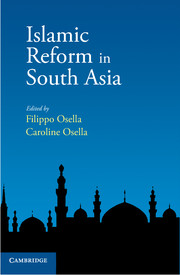Book contents
- Frontmatter
- Contents
- List of Contributors
- Introduction
- Part I Reformist Journeys
- 1 The Equivocal History of a Muslim Reformation
- 2 Islamic Reform and Modernities in South Asia
- 3 Reform Sufism in South Asia
- 4 Breathing in India, c. 1890
- Part II Debating Reform
- Part III Everyday Politics of Reform
- Part IV Reform, State and Market
- Index
2 - Islamic Reform and Modernities in South Asia
from Part I - Reformist Journeys
Published online by Cambridge University Press: 05 January 2014
- Frontmatter
- Contents
- List of Contributors
- Introduction
- Part I Reformist Journeys
- 1 The Equivocal History of a Muslim Reformation
- 2 Islamic Reform and Modernities in South Asia
- 3 Reform Sufism in South Asia
- 4 Breathing in India, c. 1890
- Part II Debating Reform
- Part III Everyday Politics of Reform
- Part IV Reform, State and Market
- Index
Summary
Introduction
From the beginning of the Islamic era, Muslim societies have experienced periods of renewal (tajdid). Since the eighteenth century, Muslim societies across the world have been subject to a prolonged and increasingly deeply felt process of renewal. This has been expressed in different ways in different contexts. Amongst political elites with immediate concerns to answer the challenges of the West, it has meant attempts to reshape Islamic knowledge and institutions in the light of Western models, a process described as Islamic modernism. Amongst ‘ulama and sufis, whose social base might lie in urban, commercial or tribal communities, it has meant ‘the reorganisation of communities… [or] the reform of individual behavior in terms of fundamental religious principles’, a development known as reformism (Lapidus 2002: 457). These processes have been expressed in movements as different as the Iranian constitutional revolution, the jihads of West Africa, and the great drives to spread reformed Islamic knowledge in India and Indonesia. In the second half of the twentieth century, the process of renewal mutated to develop a new strand, which claimed that revelation had the right to control all human experiences and that state power must be sought to achieve this end. This is known to many as Islamic fundamentalism, but is usually better understood as Islamism. For the majority of Muslims today, Islamic renewal in some shape or other has helped to mould the inner and outer realities of their lives.
- Type
- Chapter
- Information
- Islamic Reform in South Asia , pp. 26 - 50Publisher: Cambridge University PressPrint publication year: 2013
- 6
- Cited by

